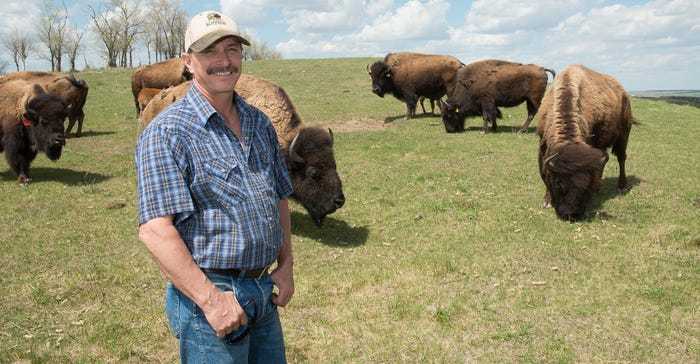August 22, 2017

By Luann Dart
As if stepping off the page of a dog-eared western novel, the shaggy bison amble up to Kevin Kraft’s pickup, quietly grunting to their calves. While Kraft is respectfully wary of the bison, one member of his original herd stretches her neck to nibble some pellets from his hand.
There are approximately 85 to 100 bison ranches in North Dakota, with a total of 6,000 to 8,000 head, according to the North Dakota Buffalo Association. Those numbers are about half of what roamed the pastures 20 years ago. But with an uptick in the niche market, the industry hopes to grow the herd numbers.
“We definitely need more people in the industry to keep up with the demand,” Kraft says.
Kraft started his herd with three bison in 1999, and has grown it to 48 animals at his ranch, Krazy K Bison, near Beulah, N.D.
“I was going to get into ranching. I had planned to go into Red Angus,” he explains. Then, during college, he helped a neighbor who owned bison.
“The more I got around buffalo, I thought this is the way to go. You don’t have to vaccinate them, you don’t have to pull calves and they eat a third less in the winter. That alone is huge,” he says.
But as a beginning rancher, Kraft had three problems: “I had no equipment, I had no animals, I had no land,” he says. So he started working full time at the nearby Dakota Gasification Co. and bought three buffalo, keeping them at a neighbor’s farm until he bought his own farmstead.
He added an extra strand to the barbed wire fences and rebuilt the corrals to their 6.5-foot height. He also created an enclosed chute system, with a crash gate at the end.
“If they can see through it or over it, they’ll go for it,” he says of the chute. Otherwise, handling the bison takes time and patience, Kraft says, as he weans the calves and works with the animals when needed.
“If you do it slowly and you don’t get them riled up, it’s like any animal. And once you learn how they think, that helps a lot, too,” he says. “They’ll tell you what their attitude is. If they’re shaking their heads and their tails are half up, they’re irritated.”
But Kraft sees more advantages with the sturdy animals. With a full-time job, he doesn’t have to tend to the animals during calving, and he has had little animal loss over the years, losing just six calves in 16 years. His cows are 18 to 19 years old on average, but some bison could be 25 to 30 years old and still calve each year, he says.
The bison roaming Kraft’s pastures are smaller than the bison of yesteryear, but they come from the same gene pool. Kraft’s cows are plains bison, and he has a bull that is a woods bison. Woods bison are taller, shaggier and have a larger hump than plains bison.
The bison remain relatively healthy. He’s only administered antibiotics to three calves over the years. He gives a bangs vaccination when selling animals across state lines. Malignant catarrhal fever, which can be found in sheep, is deadly to bison, so Kraft does not allow his bison to be sold at a sales barn that handles sheep. Kraft sells his bison calves at live auctions, but did an online auction for the first time recently.
Starting in June, he feeds his bison supplemental range cake during breeding season. A nutritionally balanced bison will calve every year, and their hair health is often a sign of their overall health, Kraft says.
As a member and former board president of the North Dakota Buffalo Association, Kraft says the industry is looking for more ranchers.
About 15 to 20 years ago, bison meat flooded the market. With little promotion to market the product, prices took a plunge, Kraft says. Many ranchers pulled out at that time.
But the low prices for bison meat influenced the market in another way.
“That price point made it more manageable for people to get it and try it,” says Kevin Leier, executive director of the North Dakota Buffalo Association, who lives near Rugby, N.D. That built a foundation of consumer demand, and bison burgers and steaks are now common menu items at midlevel restaurants.
“There’s a much more health-conscious consumer out there looking for an all-natural product,” Leier says, which has also increased demand.
Bison meat is higher in omega-3 and iron than beef and has far less marbling. The leaner meat has a more earthy flavor and must be cooked slower at a lower heat, and not be overdone, Leier shares.
“You never want to eat a bison steak over medium, because then you’ll ruin it,” he says.
Bull calves are selling for $5 a pound live weight, and some ranchers are selling weaned calves for $2,000 to $2,100 each. A fully grown bison weighs from 1,400 to 1,600 pounds. As the industry expands, the breeding market is also strong, Leier says.
“We’re seeing the most stable market in the bison industry that we’ve ever seen,” Leier says.
Dart writes from Elgin, N.D. She grew up on a grain and cattle ranch in southwest North Dakota.
You May Also Like




